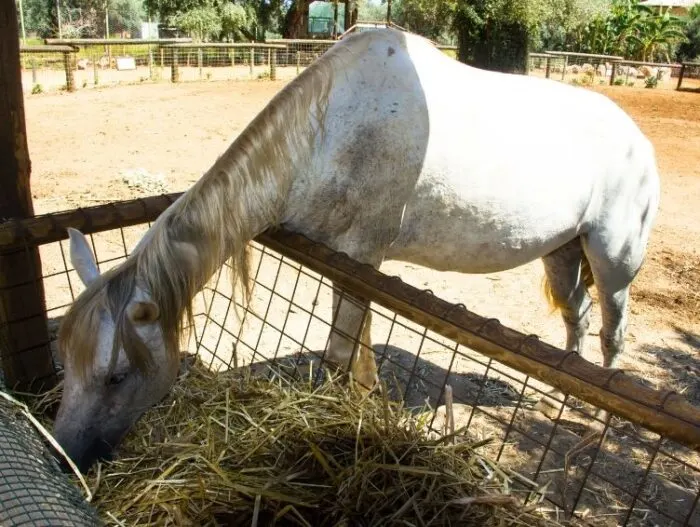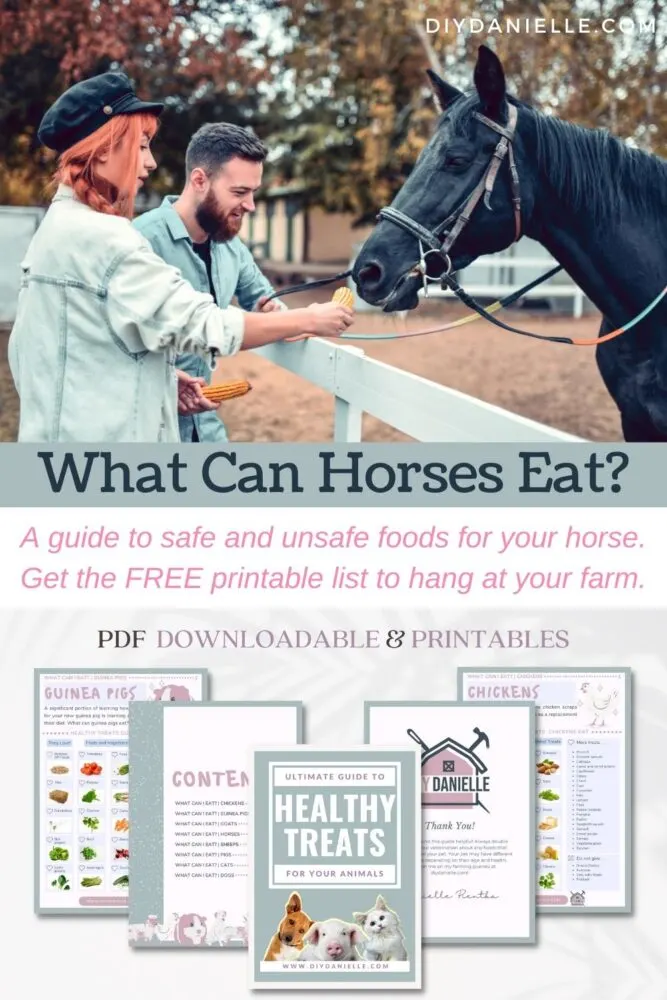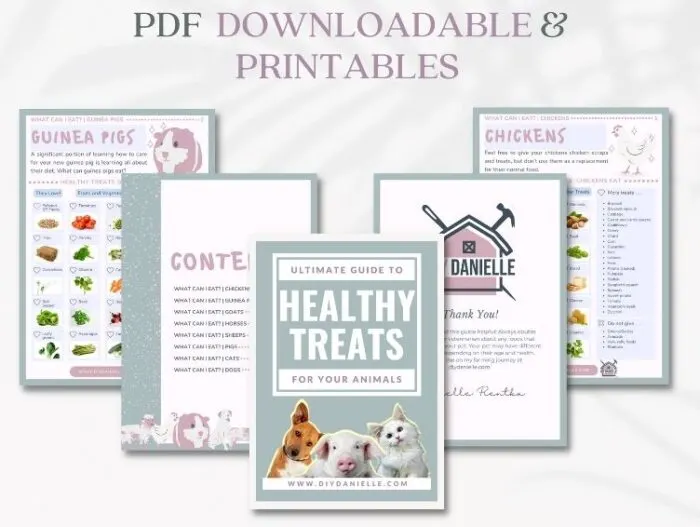Wondering what to feed your horse? Here’s a guide to what horses can eat. While hay is the most common food, here’s a list of treats too!
Equines are exceptionally large animals and need to eat anywhere from 15,000 to more than 30,000 calories per day depending on their activity level, with the hardest-working horses on the higher end of the scale. That many calories can seem almost unfathomable to a human, but rest assured, meeting their daily caloric needs is easier than it sounds.
All they really need to thrive is hay, grain, and the occasional treat. Every horse needs a different combination of the three, and it may take a while to find the perfect balance for your horse. The best practice is to weigh your horse frequently to calculate amounts of each kind of feed needed and evaluate if food is causing them to gain or lose weight and adjust feed accordingly.
This post may contain affiliate links which may earn me commissions should you click through them and take certain actions. As an affiliate for Amazon, Cricut, xTool, Home Depot, and other sites, I earn from qualifying purchases. Please DIY carefully. View my full legal disclosures here.
Please read the whole post so you don’t miss any important information!
Read on to learn more about what horses can eat!
What Can Horses Eat?
Hay
Most of the calories they need each day will come from hay. The equine digestive system is designed to process large quantities of roughage. They should be eating between 1-2.5% of their body weight each day in grasses–so if your horse weighs 1000 lbs, it should be consuming around 10-25 lbs of hay per day, depending on how much energy it expends.
It may take some time to get the perfect amount dialed in, regardless of their activity level, because individual horses naturally have different metabolic rates just like humans. If your horse is let out to graze the pasture every day, there’s most likely no need to supplement hay. Horses eat an average of 1-2 lb of hay per hour out in the field and can easily reach their limit on hay in an 8-16 hour day on the pasture.
Hay is necessary to maintain a healthy horse year-round, so you may find it necessary to supplement hay in winter months if you live in a cold climate or during times when pasture is scarce. Any hay, whether the horse is eating it straight from the ground or it’s doled out from a bale, should be of the highest quality you can get.
Hay should smell like fresh cut grass and not mildew, as this can be an indication of mold growth and could be harmful to your horse’s health. There are many different kinds of hay (and hay blends) like alfalfa, Timothy hay, fescue, bluegrass, orchard grass, etc.

When feeding hay, always calculate how much your horse is getting by the weight of the bale, not the size of the bale itself. The reason this is so important is that each bale compacts differently, and bales of the exact same size and shape can have significantly different weights. Horses depend on getting their very specific caloric intake each day for energy and maintenance of their bodily processes, so it’s important to keep the feed weight consistent.
Because they’re natural foragers with high caloric needs, they are meant to feed constantly throughout the day and should have access to food for long periods of time, even when not out to pasture. If you’re feeding your horse in a barn or a sandy run, make sure there’s at least a barrier between the ground and the feed, be it hay, grain, or a special treat, to keep your horse from ingesting large amounts of sand or bedding. You can use buckets, feeders, or mats, but you may have to experiment to find out how your horse likes to eat, as horses have preferences like people do!
Horses are designed to eat predominantly from the ground so hay ideally should be lower to the ground, or at least lower than their relaxed head height, not hung high above their heads.

For horses with excess weight or other health issues, it can be healthier for them to have restricted access to forage and a restricted amount of hay.
It’s important to discuss your horse’s needs with your veterinarian. While my mare has 24/7 pasture access and high quality hay, my vet was concerned that her weight may be a problem once her foal is weaned. We are going to create a dry lot, then see how her weight fares once her foal weans. If she becomes overweight, we will restrict forage. Excess weight can cause a lot of health problems in horses so it’s important to carefully consider their diet.
Grain
Supplementing your horse’s diet with grain may or may not be necessary, depending on how much hay they have access to and if they are able to meet their caloric needs on hay alone. Possible grains to feed your horse include sorghum, barley, oats, corn, or a mixture.
Where grain is concerned, horses need far less than hay. Under half of the total weight of their daily feed should be made up of grain, and it should be fed in small amounts throughout the day. Too much at a time can cause bloat, which can be life threatening if not dealt with right away.
If your horse gets into grain or you feel you’ve made an error in calculation and given your horse too much, call an equine vet immediately. In addition to bloat, excess grain can cause a condition called founder that affects the horse’s hooves and causes lameness.
We have several local feed stores with nutritionists who can discuss your horse’s needs and find an appropriate grain for you. Both Piper and her filly are on a higher calorie feed now due to Piper’s pregnancy and now because she’s nursing. Once her filly is weaned, her filly may still receive the higher caloric feed for a while, but they’ll eventually be reduced to minimal grain that supports a healthy weight.
Forage and hay are considered to be the better choice for feed over grain, but grain can be very helpful for putting weight on an underweight horse, as well as a great option for horses who need extra calories due to their workload (ie. a race horse is on a different feed than a horse who gets to enjoy pasture 24/7 with little formal exercise).
Commercial Feed
Commercially sold feed is also an option for your horses. Pelleted feed is often made of a mixture of grains, hay, and other essential nutrients to make sure your horse has a well-rounded diet. Just like with hay and grains, make sure you do your homework on the brand of feed you choose for your horse. Look for added ingredients that may not be the most beneficial to your horse’s diet. Molasses, for example, is a high-sugar ingredient that promises benefits like available energy, but can also contribute to laminitis of the hoof.
Treats
Offering treats is a great way to cement the bond between you and your horse while enriching their diet at the same time. Keep your horse healthy and happy by offering treats as treats and not a large part of their diet. Check the ingredients list in commercially sold treats for added sugar, but as long as you offer these treats infrequently, a small amount of sugar shouldn’t disrupt your horse’s otherwise healthy diet. You can also offer fresh fruits and veggies as treats a few times a week.
Here are some great examples of fruits and vegetables that your horse can eat:
- Carrots
- Apples (seeds and core removed)
- Bananas
- Pears (seeds and core removed)
- Stone fruit (core removed)
- Pumpkin
- Strawberries
- Celery
- Cucumber
- Melon (rind removed)
- Lettuce
- Oranges (including the peel)
- Grapes
- Sweet potato
- Zucchini
- Blueberries
- Grapefruit
I grow carrots and lettuce together in an old cracked trough by my horse pasture. This allows me to grab them fresh treats through the Summer and Fall!

Foods to Avoid Giving Your Horse
The following should be avoided as they pose various levels of risk to your horse. Always double check with your equine vet before offering your horse something new. And NEVER feed someone else’s horse without asking permission first. The wrong food can make a horse very ill or even kill it.
Never offer a horse the following:
Alliums
Vegetables in the allium family (onions/garlic/etc.) are toxic to horses and can cause damage to their red blood cells.
Brassicas
If grain can cause life-threatening cases of bloat, just imagine what kind of damage these gassy vegetables can inflict if eaten by a horse. They can also be toxic to horses. Some examples of brassicas are cauliflower, broccoli, kale, cabbage, and brussels sprouts.
Nightshades
Certain nightshades like tomatoes, potatoes, eggplants and bell peppers are toxic to horses and should not be ingested.
Meat & Dairy Products
Since your horse lives on grasses and grain, it’s pretty safe to wager that their delicate digestive systems were not built to process meat and dairy products. It’s best to avoid these if you also wish to avoid horse diarrhea.
Chocolate
Chocolate contains theobromine, which can be poisonous to horses if eaten in large amounts.
Grass Clippings
Grass clippings from mowing your yard can be covered with chemicals such as pest control spray or oil from your mower. Grass also begins to ferment once cut so it can be EXTREMELY unhealthy for animals with sensitive digestive systems such as horses. Neighbors with good intentions, but no knowledge of horse health have caused MANY unnecessary vet visits and bills.

Free Printable List of Foods Horses Can Eat!
Now you’ve got the basics and you’re ready to begin the trial-and-error process to learn what works best for your horse: what balance of feed keeps them at a healthy weight, whether you’ll be pasture or barn feeding, if your horse prefers a trough or a feeding mat, and what kind of treats your horse favors. It’s a long and sometimes arduous process but it will be well worth the trouble in the end when you’re rewarded with a happy, healthy horse.
I have a printable bundle of foods for different farm animals and household pets. Subscribers can get the printable FREE by signing up below!
Love horses? Check out: Custom Tote Bag for Horse Lover | Composting Horse Manure | DIY Saddle Rack | Rolling Feed Bins. Check out more horse care tips and tricks from DIY Danielle here!
Please share and pin this post! If you make this project, share it in our Stuff Mama Makes Facebook Group. We have regular giveaways for gift cards to craft stores. You can also tag me on Instagram @doityourselfdanielle; I love seeing everything you make!

Google Web Story: Pet Organization Ideas

